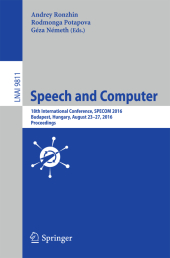 Neuerscheinungen 2016Stand: 2020-02-01 |
Schnellsuche
ISBN/Stichwort/Autor
|
Herderstraße 10
10625 Berlin
Tel.: 030 315 714 16
Fax 030 315 714 14
info@buchspektrum.de |

Géza Németh, Rodmonga Potapova, Andrey Ronzhin
(Beteiligte)
Speech and Computer
18th International Conference, SPECOM 2016, Budapest, Hungary, August 23-27, 2016, Proceedings
Herausgegeben von Ronzhin, Andrey; Potapova, Rodmonga; Németh, Géza
1st ed. 2016. 2016. xviii, 731 S. 197 SW-Abb. 235 mm
Verlag/Jahr: SPRINGER, BERLIN; SPRINGER INTERNATIONAL PUBLISHING 2016
ISBN: 3-319-43957-X (331943957X)
Neue ISBN: 978-3-319-43957-0 (9783319439570)
Preis und Lieferzeit: Bitte klicken
This book constitutes the proceedings of the 18th International Conference on Speech and Computer, SPECOM 2016, held in Budapest, Hungary, in August 2016. The 85 papers presented in this volume were carefully reviewed and selected from 154 submissions.
´Automatic Speech Recognition based on Neural Networks.- Machine Processing of Dialogue States; Speculations on Conversational Entropy.- Speech Recognition Challenges in the Car Navigation Industry.- A Comparison of Acoustic Features of Speech of Typically Developing Children and Children with Autism Spectrum Disorders.- A Deep Neural Networks (DNN) Based models for a Computer Aided Pronunciation Learning System.- A Linguistic Interpretation of the Atom Decomposition of Fundamental Frequency Contour for American English.- A Phonetic Segmentation Procedure Based on Hidden Markov Models.- A Preliminary Exploration of Group Social Engagement Level Recognition in Multiparty Casual Conversation.- An Agonist-Antagonist Pitch Production Model.- An Algorithm for Phase Manipulation in a Speech Signal.- An Exploratory Study on Sociolinguistic Variation of Russian Everyday Speech.- Adaptation of DNN Acoustic Models using KL-divergence Regularization and Multi-Task Training.- Advances in STC Russian Spontaneous Speech Recognition System.- Approaches for Out-of-Domain Adaptation to Improve Speaker Recognition Performance.- Assessment of the Relation Between Low-Frequency Features and Velum Opening by Using Real Articulatory Data.- Automatic Summarization of Highly Spontaneous Speech.- Backchanneling via Twitter Data for Conversational Dialogue Systems.- Bio-Inspired Sparse Representation of Speech and Audio Using Psychoacoustic Adaptive Matching Pursuit.- Combining Atom Decomposition of the F0 Track and HMM-based Phonological Phrase Modelling for Robust Stress Detection in Speech.- Comparative analysis of classifiers for automatic language recognition in spontaneous speech.- Comparison of Retrieval Approaches and Blind Relevance Feedback Methods within the Czech Speech Information Retrieval.- Convolutional Neural Network in the Task of Speaker Change Detection.- Design of a Speech Corpus for Research on Cross-Lingual Prosody Transfer.- Designing High-Coverage Multi-Level Text Corpus for Non-Professional-Voice Conservation.- Designing Syllable Models for an HMM based Speech Recognition System.- Detecting Filled Pauses and Lengthenings in Russian Spontaneous Speech using SVM.- Detecting Laughter and Filler Events by Time Series Smoothing with Genetic Algorithms.- Detecting State of Aggression in Sentences using CNN.- DNN-based Acoustic Modeling for Russian Speech Recognition Using Kaldi.- DNN-Based Duration Modeling for Synthesizing Short Sentences.- Emotional Speech of 3-Years Old Children: Norm-Risk-Deprivation.- Ensemble Deep Neural Network based Waveform-Driven Stress Model for Speech Synthesis.- Evaluation of Response Times on a Touch Screen using Stereo Panned Speech Command Auditory Feedback.- Evaluation of the Speech Quality During Rehabilitation after Surgical Treatment of the Cancer of Oral Cavity and Oropharynx based on a Comparison of the Fourier Spectra.- Experiments with One-Class Classifier as a Predictor of Spectral Discontinuities in Unit Concatenation.- Exploring GMM-derived Features for Unsupervised Adaptation of Deep Neural Network Acoustic Models.- Feature Space VTS with Phase Term Modeling.- Finding Speaker Position Under Difficult Acoustic Conditions.- Fusing Various Audio Feature Sets for Detection of Parkinson´s Disease from Sustained Voice and Speech Recordings.- HAVRUS Corpus: High-speed Recordings of Audio-Visual Russian Speech.- Human-Smartphone Interaction for Dangerous Situation Detection & Recommendation Generation while Driving.- Improving Automatic Speech Recognition Containing Additive Noise Using Deep Denoising Autoencoders of LSTM Networks.- Improving the Quality of Automatic Speech Recognition in Trucks.- Improving Recognition of Dysarthric Speech Using Severity Based Tempo Adaptation.- Improving Robustness of Speaker Verification by Fusion of Prompted Text-Dependent & Text-Independent Operation Modalities.


